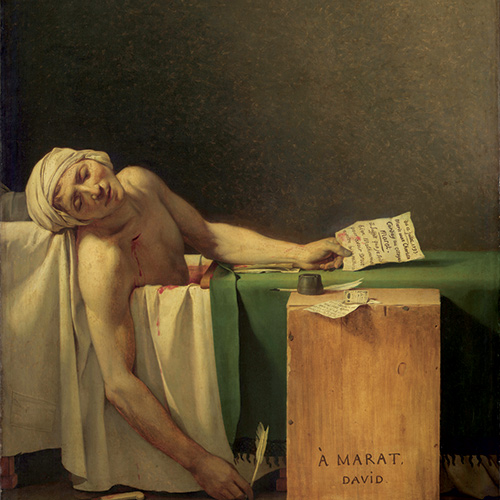
The Death of Marat, 1793, by Jacques-Louis David (Royal Museums of Fine Arts of Belgium)
Artists such as Picasso, David, and Goya came to grips with the political upheavals of their day with heroic and searing images that elicit our admiration or moral outrage. Picasso’s Guernica is more than a fractured scene of the horror, pain, and chaos during the bombing of a Basque town. It is also an indelible political statement about the tragedies of modern technological warfare, especially the indiscriminate killing of civilians. Jacques-Louis David’s Death of Marat and Napoleon Crossing the Alps paint the French Revolution and Napoleonic wars in heroic, mythic terms. But Francisco Goya’s The Third of May 1808 is a scathing indictment of those wars. This interplay between artistic expression and social and political content is a complex one.
Art historian Judy Scott Feldman looks at four historical turning points and the artists who responded to religious, social, and political upheaval with powerful artworks that continue to resonate today.
February 5 The Christianization of the Roman Empire: New God, New Art
After Constantine the Great converted to Christianity in 312 C.E., and Christianity became the official religion of the Roman Empire at the end of the 4th century, ancient pagan beliefs were abandoned and new Christian practices invented. How did classical artists and architects trained in the making of statues of pagan gods and temples create new kinds of art that remain enduring monuments to the transformation of classical antiquity and Roman identity at this pivotal moment in Western civilization?
February 12 Protestant Reformation and Catholic Counter-Reformation: Artists Take Up the Cause
To make or to break images? That was a question during the Protestant Reformation and Catholic Counter-Reformation. Protestant reformers called on followers to strip churches of biblical paintings and statues, believing they violated the commandment against the making of graven images. Artists sought out new patrons besides the Church, and new subjects including portraiture and landscape. In contrast, artists in Catholic lands thrived as the Church reaffirmed and promoted religious art as a crucial aid to Christian worship and piety.
February 19 The French Revolution and Napoleon: Contrasting Visions of David and Goya
One of the most politically engaged as well as artistically prolific artists during the French Revolution was Jacques-Louis David. His earliest paintings from the 1780s seemed to foreshadow the political ideals and fervor of the 1789 Revolution. Within a decade he was its official painter, then played the same role for Napoleon—as well as propogandist. Paintings of stark realism by Francisco Goya and Paul Delaroche challenge David’s mythmaking.
February 26 The 1893 World’s Columbian Exhibition and the New American Century
The United States proclaimed its coming of age on the international stage with the World’s Columbian Exhibition in 1893, also known as the Chicago World’s Fair. Architect Daniel Burnham and landscape architect Frederick Law Olmsted designed the grand “White City” setting that inspired a whole new generation of American architects and urban designers, including the McMillan Commission that redesigned the National Mall in Washington, D.C. Exhibits of science, history, art, and anthropology stimulated new forms and subjects in art, some of which can be seen on the walls of the profusely decorated Library of Congress building. How does that legacy speak to us today?
4 sessions
World Art History Certificate elective: Earn 1 credit*
General Information
*Enrolled participants in the World Art History Certificate Program receive 1 elective credit. Not yet enrolled? Learn about the program, its benefits, and how to register here.